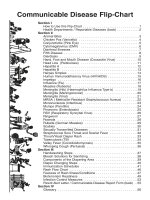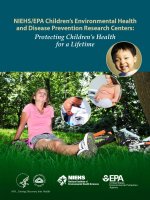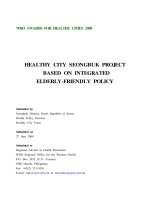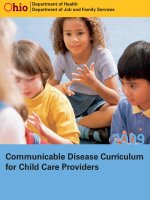LESSONS ON COMMUNICABLE DISEASE PREVENTION K-12 docx
Bạn đang xem bản rút gọn của tài liệu. Xem và tải ngay bản đầy đủ của tài liệu tại đây (1.16 MB, 68 trang )
LESSONS ON
COMMUNICABLE
DISEASE
PREVENTION
K-12
Student Services/Prevention
and Wellness Team
WISCONSIN DEPARTMENT OF PUBLIC INSTRUCTION
E
LIZABETH BURMASTER, STATE SUPERINTENDENT
This publication is available from:
Student Services/Prevention and Wellness Team
Wisconsin Department of Public Instruction
125 South Webster Street
P.O. Box 7841
Madison, Wisconsin 53707-7841
(608) 266-8960
(800) 441-4563
This document is also available on the World Wide Web:
dpi.wi.gov/sspw/___________________
First Edition
May 2009
Wisconsin Department of Public Instruction
The Wisconsin Department of Public Instruction does not discriminate on the basis of sex, race, religion,
age, national origin, ancestry, creed, pregnancy, marital or parental status, sexual orientation, or physical,
mental, emotional, or learning disability.
Printed on
Recycled Paper
Acknowledgements
The Wisconsin Department of Public Instruction (DPI) staff of the Student Services Prevention
and Wellness Team responded to the need for prevention strategies to address the spread of
communicable disease. One of the strategies was to develop a set of lessons for elementary,
middle, and high school students that were engaging, age appropriate, and could connect to a
number of content areas such as Science, Art, Music and Social Studies and put them on the DPI
Pandemic Flu web site for use by teachers. The lessons were adapted or developed by Jon W.
Hisgen, Health and Physical Activity Consultant. Linda Carey served as the editor of the
document.
Reviewers
Douglas White, Director
Student Services Prevention and Wellness Team, DPI
Rachel Gallagher
Consultant, School Nursing Services, DPI
Special thanks to the many teachers who helped develop the original performance based lessons
that were a part of DPI's School Health Performance Item development group.
iii
Table of Contents
Elementary School
Hand Washing Concept Map 1
Stop the Spread of Disease 7
You are the Teacher 11
How Vaccines Work 15
Middle School
Inspector Bacterium 21
The Germs Go Marching In 27
Archaeological Dig 33
Middle or High School
The Great CDC Scavenger Hunt 41
Who Gets the Drug? 47
Attack of the Super Bug 53
iv
Elementary
School
1
Content Area: Communicable Disease Prevention
Performance Task: “Hand Washing Concept Map”
Educational Level: Elementary School
Student Instructions
After learning about how to wash our hands and the importance of washing hands properly,
you show what you have learned by completing a hand washing concept map.
Answers will be scored on the following:
Assessment Criteria
1. How well you complete the concept map with correct information.
2. How well you understand why we should wash our hands.
3. How well you understand when to wash our hands.
4. How well you understand how to properly wash hands.
5. How well you understand what can be done when we are unable to wash our hands
properly.
2
After learning all about washing our hands, let’s fill in this concept map!
Washing our Hands
Washing our Hands
When should
we wash our
hands?
How should we
wash our
hands?
What can we
do if we need to
wash our hands
and there is no
sink or hot
water?
Why is it
important to
wash our hands
?
3
Content Area: Communicable Disease Prevention
Performance Task: “Hand Washing Concept Map”
Educational Level: Elementary School
Teacher Information
Language Arts, Health Education
Curriculum Connections
Students create the attached concept map on different aspects of hand washing.
Overview
Students receive a copy of the hand washing concept map to fill in responses to questions.
Students show understanding of
when
,
how
, and
what
of washing hands as well as
what
precautions can be taken in a situation where appropriate hand washing facilities are not
available.
Requirements
This assessment can be completed in one class period.
Time
Hand washing concept map, pen, or pencil
Materials
4
Provide instruction on various aspects of hand washing, including instruction on the spread
of bacteria and possible use of hand sanitizers. A glow germ presentation might be
helpful.
Instructions
Answers will be scored on the following:
Assessment Criteria
Students show how well they understand the when, how, and why of hand washing as well
as what to do when appropriate hand washing facilities are not available.
Wisconsin Health Education Standards
A
Disease prevention and health promotion
B Health behavior
C Goal setting and decision-making
D
Accessing accurate information
E Impact of culture and media
F Communication skills
G
Advocacy
5
Hand washing is the single most important prevention step for reducing the spread of
disease. Hands should always be washed upon exiting animal areas and before eating or
drinking.
Sample Response
HOW
Wet hands with running water; place soap in palms; rub together to make a lather; scrub
hands vigorously as you say the ABC song.
Dry hands with a clean towel. Do not dry hands on clothing.
WHEN
After touching animals.
Before eating.
After using rest rooms.
WHY
It is the single most important prevention step for reducing the spread of disease.
WHAT
Use hot water if possible. If only cold water is available, use a soap that works effectively
in cold water. If there is no sink, running water that has some pressure and volume will
work if there is soap available. Hand sanitizers can work if no other hand washing station is
available.
6
7
Content Area: Communicable Disease Prevention
Performance Event: “Stop the Spread of Disease”
Educational Level: Elementary School
Student Instructions
In this activity, you will make a
Stop the Spread of Disease
book. On each page of your
booklet is listed a general healthy behavior that works to stop the spread of disease. Draw
a picture of that healthy behavior and print information that explains your drawing so that
students your age can understand your explanation. When your booklet is finished, make a
cover and write a title on it.
Your booklet should include the following:
1. A book cover with a title.
2. A page for each healthy behavior. List the behavior, draw a picture of the
behavior, and tell about your behavior.
Answers will be scored on the following:
Assessment Criteria
1. How well you understand health information on healthy hygiene.
2. How well you demonstrate an understanding of individual responsibility as it applies
to healthy behaviors.
8
9
Content Area: Communicable Disease Prevention
Performance Event: “Stop the Spread of Disease”
Educational Level: Elementary School
Teacher Information
Curriculum Connections
Art, Language Arts, Health Education
Overview
This activity promotes the practice of healthy behaviors.
Requirements
Children in the primary grades will make booklets to promote healthy behaviors. They
should include the following:
• Hand washing.
• Proper coughing technique.
• What to do if you begin coughing, have a headache, or start to sneeze.
• When to tell parents, teachers, or school nurses about how you feel.
• Other behaviors you think are important to stop the spread of disease.
Each page of the booklet should list one healthy behavior, illustrate the behavior, and
include information about the behavior. Students assemble their work into a booklet with
cover pages of two sheets of construction paper. They design a cover and give their
booklet a title. If time permits, the students could read their booklets to other students.
Teachers may want to include pages on how diseases spread. This is an individual
assignment.
Time
This task will take two class periods to complete.
Materials
Students will need paper labeled with behaviors, construction paper, pencils, markers or
crayons, and a stapler.
Instruction
Explain how personal health choices and behaviors play an important role in disease
prevention.
10
Assessment Criteria
Answers will be scored on the following:
1. How well students understand health information to prevent the spread of disease.
2. How well students demonstrate an understanding of the impact individual responsibility
has on healthy behaviors.
Wisconsin Health Education Standards
A Disease prevention and health promotion
B Health behavior
C
Goal setting and decision-making
D Accessing accurate information
E Impact of culture and media
F
Communication skills
G Advocacy
Sample Response
Cover and Title
*
The Stop the Spread Train
Drawing of a train with five cars, each one representing one health behavior. The behavior
is listed on the side of each car.
Healthy Habit One:
Washing hands before eating will prevent the children from getting germs in their mouth
or on their food from dirty hands.
Healthy Habit Two:
*
When you cough, do it right.
Cough into your clothes on your arm.
Healthy Habit Three:
*
Tell you teacher, nurse, or parent.
If you have a fever or you’re sneezing or coughing, tell someone who can help.
Health Habit Four:
*
Use a hand sanitizer.
When there is no place for hand washing use a hand sanitizer.
11
Content Area: Communicable Disease Prevention
Performance Event: “You are the Teacher”
Educational Level: Elementary School
Student Instructions
In this activity, you will choose one of the following safe behaviors and create a poster and
what you would say to someone else about why this behavior is important. Draw a picture
of that healthy behavior, include any prevention materials to be used, and print
information that explains your drawing so that students your age can understand your
explanation. When your poster is finished you are going to share it with the rest of the
class.
Choose one of the following
1. Communicable disease is spread by coughing or sneezing.
2. Cover your nose and mouth with a tissue when you cough or sneeze. Throw the
tissue in the trash after you use it.
3. Wash your hands with soap and water, especially after you cough or sneeze.
4. Alcohol-based hand cleaners called sanitizers are also effective.
5. Clean your desk with disinfecting wipes often.
6. Avoid touching your eyes, nose, or mouth.
7. If you think you are becoming sick or you are speaking to someone who sneezes or
coughs, keep a social distance away from that person.
8. Stay home if you get sick.
Assessment Criteria
Answers will be scored on the following:
1. How well you understand health information on healthy hygiene and prevention of the
spread of disease.
2. How well you demonstrate an understanding of healthy behaviors as it applies to the
prevention of the spread of disease.
12
13
Content Area: Communicable Disease Prevention
Performance Event: “You are the Teacher”
Educational Level: Elementary School
Teacher Information
Curriculum Connections
Art, Language Arts, Health Education
Overview
This activity promotes the practice of healthy behaviors.
Requirements
In this activity, the student will choose one of the following safe behaviors and create a
poster and what they would say to someone else about why this behavior is important.
Draw a picture of that healthy behavior, include any prevention materials to be used, and
print information that explains the drawing so that other students their age can
understand the explanation. When the poster is finished each student is going to share it
with the rest of the class.
Choose one of the following
1. Communicable disease is spread by coughing or sneezing.
2. Cover your nose and mouth with a tissue when you cough or sneeze. Throw the
tissue in the trash after you use it.
3. Wash your hands with soap and water, especially after you cough or sneeze.
4. Alcohol-based hand cleaners called sanitizers are also effective.
5. Clean your desk with disinfecting wipes often.
6. Avoid touching your eyes, nose, or mouth.
7. If you think you are becoming sick or you are speaking to someone who sneezes or
coughs, keep a social distance away from that person.
8. Stay home if you get sick.
Time
This task will take two class periods to complete and present to the rest of the class.
Materials
Students will need paper labeled with behaviors, construction paper, pencils, markers or
crayons, and a stapler. Pictures or real examples of such things as tissue paper, soap,
disinfecting wipes, alcohol-based hand cleaners will help bring realism to the poster.
14
Instruction
Explain how personal prevention choices and behaviors play an important role in disease
prevention.
Assessment Criteria
Answers will be scored on the following:
1. How well the student understands health information on healthy hygiene and
prevention of the spread of disease.
2. How well the student demonstrates an understanding of healthy behaviors as it
applies to the prevention of the spread of disease.
Wisconsin Health Education Standards
A
Disease prevention and health promotion
B Health behavior
C Goal setting and decision-making
D
Accessing accurate information
E Impact of culture and media
F Communication skills
G
Advocacy
Sample Response
I keep my world clean of viruses because I use Disinfecting Wipes.
Poster of a student cleaning their desk with wipes.
I would use this product because it cleans almost all germs and kills the flu virus.
15
Content Area: Communicable Disease Prevention
Performance Event: “How Vaccines Work”
Educational Level: Elementary School
Student Instructions
You are asked to show how germs make us sick, how our bodies fight infection, and how
vaccines work. In small groups of three, invent a sickness and present the following:
1. Draw what a germ looks like under the microscope.
2. Draw how the germ is transmitted or spread.
3. Draw the symptoms of the infection.
4. Explain how the disease can be prevented by the use of a vaccine. Include pictures
of the antigen (germ) and the antibody (fighter cell).
5. Use the lock and key concept to form this explanation—the fighter cell locks up the
germ so it can no longer harm the body.
6. Describe the model to the class.
Assessment Criteria
Answers will be scored on the following:
1. How well you show that you understand the health information about how vaccines
work.
2. How well you explain the benefits of the following:
• Being responsible for your own health.
• Avoiding a threatening situation.
16
17
Content Area: Communicable Disease Prevention
Performance Event: “How Vaccines Work”
Educational Level: Elementary School
Teacher Information
Curriculum Connections
Art, Science, Health Education
Overview
This activity will help you see how well students understand the role of vaccines in
preventing disease. Although the children know they go see the doctor to get shots, it is
necessary for the students to learn what vaccines are and how they work.
Requirements
Students will need to have previous instruction on how germs can make us sick, how the
immune system works, and how vaccines prevent certain diseases.
Time
This task will take two to three class periods to complete and present to the rest of the
class.
Materials
Markers or crayons, a pen, or a pencil.
Instruction
Prior to the lesson develop a lock and key model of the class activity by using a real germ
and sickness like chicken pox. You may wish to invite the school nurse or another health
care professional to provide further discussions on prevention and control of disease.
Assessment Criteria
Answers will be scored on the following:
1. How well the student shows an understanding of the health information about
how vaccines work.
2. How well the student explains the benefits of the following:
• Being responsible for your own health.
• Avoiding a threatening situation.









